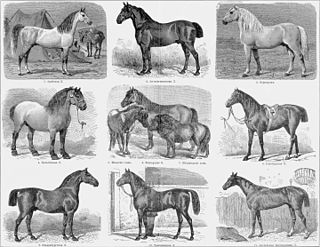
A horse breed is a selectively bred population of domesticated horses, often with pedigrees recorded in a breed registry. However, the term is sometimes used in a broader sense to define landrace animals of a common phenotype located within a limited geographic region, or even feral "breeds" that are naturally selected. Depending on definition, hundreds of "breeds" exist today, developed for many different uses. Horse breeds are loosely divided into three categories based on general temperament: spirited "hot bloods" with speed and endurance; "cold bloods," such as draft horses and some ponies, suitable for slow, heavy work; and "warmbloods," developed from crosses between hot bloods and cold bloods, often focusing on creating breeds for specific riding purposes, particularly in Europe.
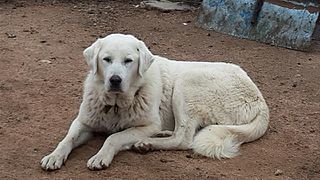
The Akbash, is a traditional Turkish breed or type of flock guardian dog from western Anatolia. The word akbaş means 'white head', and thus distinguishes this dog from the Karabaş, or 'black head'. It was recognised by the Turkish Ministry of Agriculture and Rural Affairs in 2006; it is under the tutelage of the Köpek Irkları ve Kinoloji Federasyonu, the Turkish dog breed society, but is not recognised by the Fédération Cynologique Internationale.
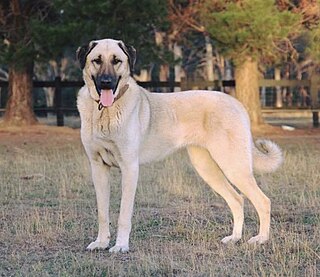
The Kangal Shepherd Dog is a traditional Turkish breed of large livestock guardian dog. The breed name derives from that of the town and district of Kangal in Sivas Province, the easternmost province of the Central Anatolia Region in central Turkey. The coat colour varies from pale fawn to wolf grey, always with a black mask.
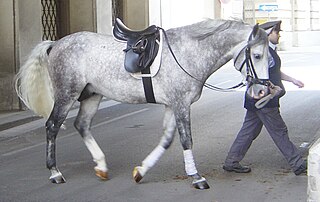
A gray horse has a coat color characterized by progressive depigmentation of the colored hairs of the coat. Most gray horses have black skin and dark eyes; unlike some equine dilution genes and some other genes that lead to depigmentation, gray does not affect skin or eye color. Gray horses may be born any base color, depending on other color genes present. White hairs begin to appear at or shortly after birth and become progressively more prevalent as the horse ages as white hairs become intermingled with hairs of other colors. Graying can occur at different rates—very quickly on one horse and very slowly on another. As adults, most gray horses eventually become completely white, though some retain intermixed light and dark hairs.
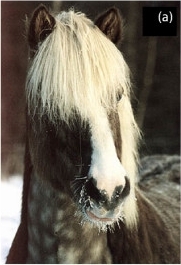
The silver or silver dapple (Z) gene is a dilution gene that affects the black base coat color and is associated with Multiple Congenital Ocular Abnormalities. It will typically dilute a black mane and tail to a silvery gray or flaxen color, and a black body to a chocolaty brown, sometimes with dapples. It is responsible for a group of coat colors in horses called "silver dapple" in the west, or "taffy" in Australia. The most common colors in this category are black silver and bay silver, referring to the respective underlying coat color.
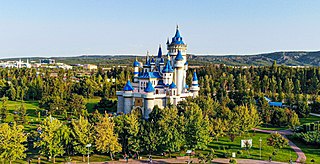
Eskişehir is a city in northwestern Turkey and the capital of the Eskişehir Province. The urban population of the city is 898,369 with a metropolitan population of 797,708. The city is located on the banks of the Porsuk River, 792 m above sea level, where it overlooks the fertile Phrygian Valley. In the nearby hills one can find hot springs. The city is 233 km (145 mi) to the west of Ankara, 330 km (205 mi) to the southeast of Istanbul and 78 km (48 mi) to the northeast of Kütahya. It is located in the vicinity of the ancient city of Dorylaeum. Known as a university town; Eskişehir Technical University, Eskişehir Osmangazi University, and Anadolu University are based in Eskişehir. The province covers an area of 2,678 km2 (1,034 sq mi).

Horses exhibit a diverse array of coat colors and distinctive markings. A specialized vocabulary has evolved to describe them.

Markings on horses are usually distinctive white areas on an otherwise dark base coat color. Most horses have some markings, and they help to identify the horse as a unique individual. Markings are present at birth and do not change over the course of the horse's life. Most markings have pink skin underneath most of the white hairs, though a few faint markings may occasionally have white hair with no underlying pink skin. Markings may appear to change slightly when a horse grows or sheds its winter coat, however this difference is simply a factor of hair coat length; the underlying pattern does not change.
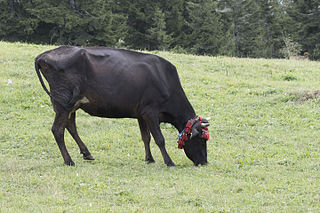
The Anatolian Black, also known as Native Black Cattle, is a breed of cattle that originated in Anatolia, in what is now Turkey. They are used in dairy production, meat production, and as draught animals on small farms. They are primarily raised in central Turkey.

A pony is a type of small horse. Depending on the context, a pony may be a horse that is under a given height at the withers, or a small horse with a specific conformation and temperament. Compared to a larger horse, a pony may have a thicker coat, mane and tail, with proportionally shorter legs, a wider barrel, heavier bone, a thicker neck and a shorter, broader head. The word pony derives from the old French poulenet, meaning foal, a young, immature horse.

Roan is a horse coat color pattern characterized by an even mixture of colored and white hairs on the body, while the head and "points"—lower legs, mane, and tail—are mostly solid-colored. Horses with roan coats have white hairs evenly intermingled throughout any other color. The head, legs, mane, and tail have fewer scattered white hairs or none at all. The roan pattern is dominantly inherited, and is found in many horse breeds. While the specific mutation responsible for roan has not been exactly identified, a DNA test can determine zygosity for roan in several breeds. True roan is always present at birth, though it may be hard to see until after the foal coat sheds out. The coat may lighten or darken from winter to summer, but unlike the gray coat color, which also begins with intermixed white and colored hairs, roans do not become progressively lighter in color as they age. The silvering effect of mixed white and colored hairs can create coats that look bluish or pinkish.
The Rize Koyan is a breed of livestock guardian dog from north Black Sea shore in Turkey.

Diriliş: Ertuğrul, translated as Resurrection: Ertuğrul, is a Turkish historical fiction and adventure television series produced by Mehmet Bozdağ for TRT, starring Engin Altan Düzyatan as Ertuğrul Bey. The show is set in the 13th century and is based on the life of Ertuğrul, the father of Osman I, the founder of the Ottoman Empire.
The Kars, known as the Kars Köpeği in Turkish, is a breed of livestock guardian dog from eastern Turkey.
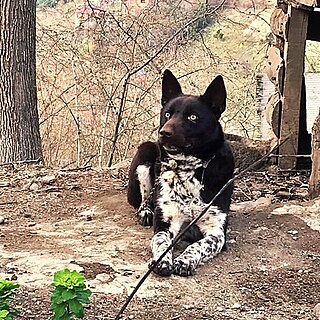
The Zerdava is an aboriginal laika dog breed native to Black Sea region of Turkey and Georgia. Zerdava are traditionally used as guard and hunting dog and are especially prized for boar hunting. The name “Zerdava” is Slavic for mustelid, possibly in reference to their Marten-brown color or their treeing behavior when hunting martens.
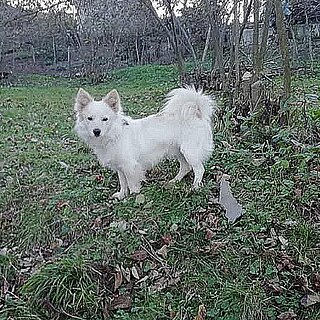
The Tonya Finosu is a white spitz dog indigenous to Trabzon, Turkey, especially the city of Tonya. Tonya Finosu are valued both for their natural suspicion of strangers as well as their playfulness and affection with their family.
The Dikkulak is a small spitz dog native to the Agri, Ardahan, Erzurum, Igdir, and Kars provinces in Turkey, the same areas as the Kangal. It is used as a small guard dog.













